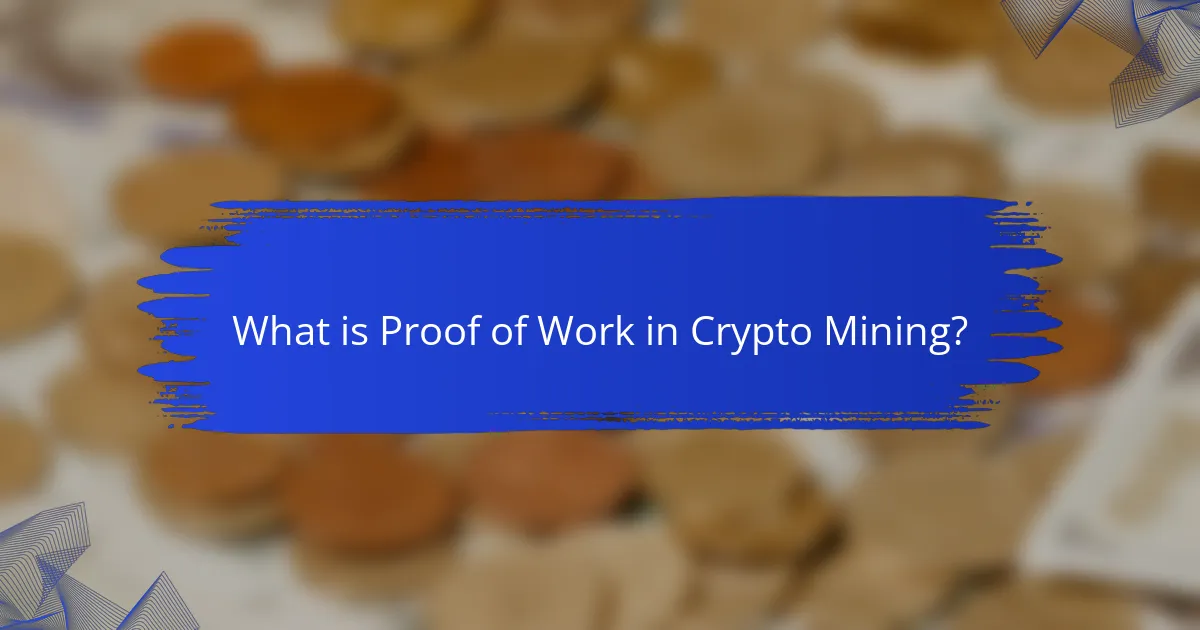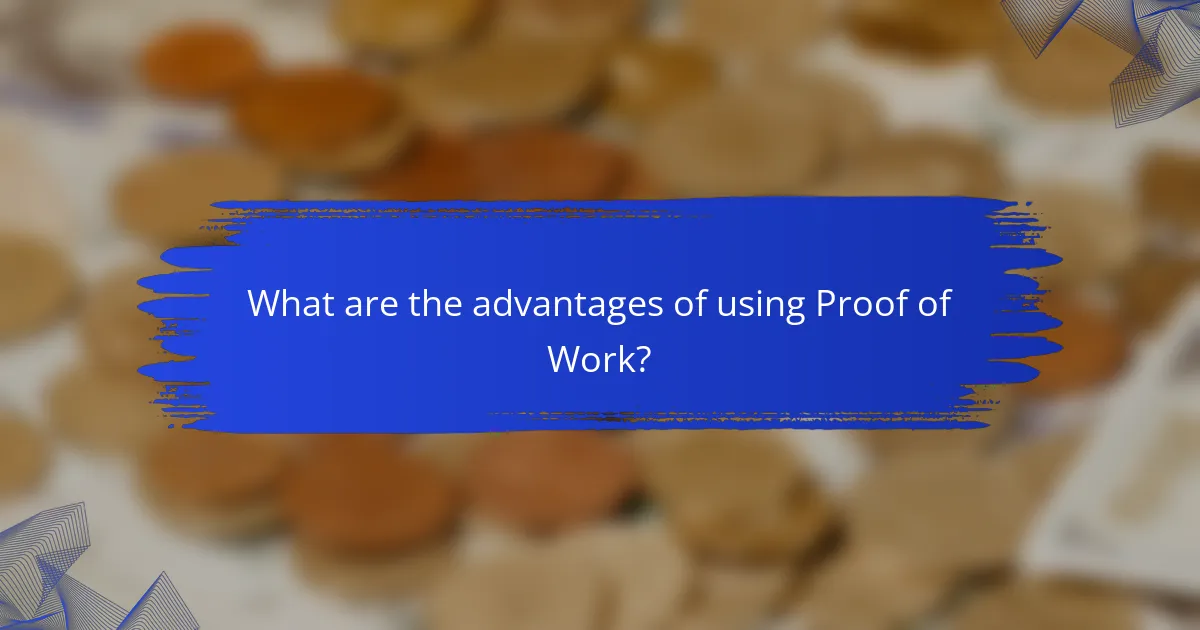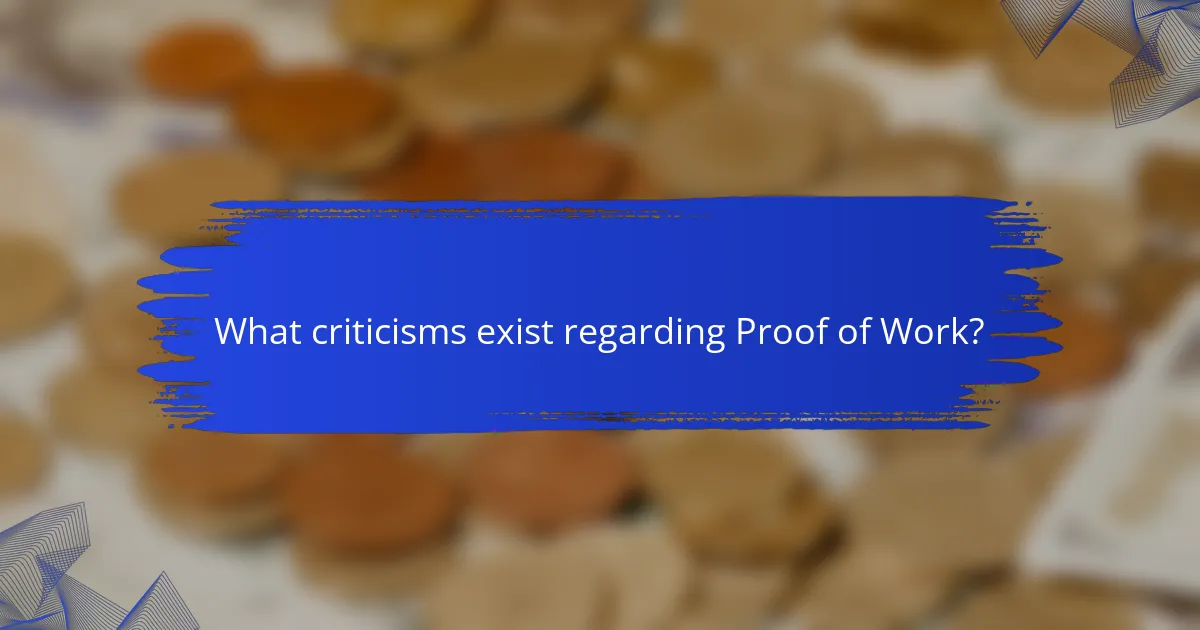Proof of Work (PoW) is a consensus mechanism essential for validating transactions in cryptocurrency mining, notably utilized by Bitcoin. This process involves miners solving complex mathematical problems to secure the network against double-spending and fraudulent activities. While PoW enhances security and decentralization, it faces significant criticisms, including high energy consumption, potential centralization of mining power, and increased transaction fees during peak demand. The article will explore the mechanisms of PoW, its advantages in ensuring network integrity, and the challenges it presents within the cryptocurrency landscape.

What is Proof of Work in Crypto Mining?
Proof of Work (PoW) is a consensus mechanism used in cryptocurrency mining. It requires miners to solve complex mathematical problems to validate transactions. This process secures the network and prevents double-spending. Miners compete to be the first to solve these problems. The first to succeed adds a new block to the blockchain. PoW consumes significant computational power and energy. Bitcoin, launched in 2009, is the most notable example using PoW. This method ensures network security by making attacks costly and impractical.
How does Proof of Work function within blockchain technology?
Proof of Work (PoW) functions as a consensus mechanism in blockchain technology. It requires participants, known as miners, to solve complex mathematical problems. This process validates transactions and adds them to the blockchain. Once a miner successfully solves a problem, they broadcast the solution to the network. Other miners verify the solution before the new block is added to the chain. PoW secures the network by making it computationally expensive to alter any part of the blockchain. This mechanism was first implemented in Bitcoin, which uses the SHA-256 hashing algorithm. The energy consumption of PoW has been a topic of debate, with estimates suggesting Bitcoin mining consumes around 100 terawatt-hours annually.
What are the key processes involved in Proof of Work?
Proof of Work involves several key processes. The first step is transaction verification. Miners collect pending transactions from the network. Next, miners bundle these transactions into a block. After that, they compete to solve a complex mathematical puzzle. This puzzle requires significant computational power. The first miner to solve the puzzle broadcasts the solution to the network. Other miners verify the solution’s accuracy. If verified, the new block is added to the blockchain. This process ensures network security and integrity.
How does Proof of Work ensure network security?
Proof of Work ensures network security by requiring miners to solve complex mathematical problems. This process makes it computationally expensive and time-consuming to validate transactions. As a result, an attacker would need to control more than 50% of the network’s total computational power to successfully alter the blockchain. This is highly impractical due to the significant resources needed for such control. The decentralized nature of the network further complicates coordinated attacks. Additionally, the energy consumption associated with mining acts as a deterrent against malicious activities. Historical data shows that networks using Proof of Work, like Bitcoin, have remained secure over time despite attempted attacks.
Why was Proof of Work developed for cryptocurrencies?
Proof of Work was developed for cryptocurrencies to secure the network and prevent double-spending. It requires miners to solve complex mathematical problems to validate transactions. This process makes it costly and time-consuming to alter transaction history. The first cryptocurrency, Bitcoin, utilized Proof of Work to establish trust without a central authority. By requiring computational effort, it deters malicious actors from easily attacking the network. The system also incentivizes miners with rewards for their computational work. This model has been foundational in creating decentralized and secure digital currencies.
What problems does Proof of Work aim to solve?
Proof of Work aims to solve the problem of double spending in digital currencies. It ensures that transactions are verified and added to the blockchain in a secure manner. This mechanism requires miners to perform complex calculations, which makes it costly to alter transaction history. Additionally, Proof of Work addresses the issue of trust in decentralized networks. By requiring computational effort, it prevents malicious actors from easily manipulating the system. The consensus achieved through Proof of Work creates a reliable and tamper-resistant ledger. This method has been foundational in cryptocurrencies like Bitcoin, which relies on it to maintain integrity and security.
How has Proof of Work evolved since its inception?
Proof of Work (PoW) has evolved significantly since its inception in 2009 with Bitcoin. Initially, PoW served as a mechanism to secure the Bitcoin network against double-spending. It required miners to solve complex mathematical puzzles to validate transactions and create new blocks. Over the years, various cryptocurrencies adopted PoW, leading to innovations in mining algorithms and hardware.
For instance, Ethereum introduced Ethash, a memory-hard PoW algorithm to promote decentralization. Additionally, concerns about energy consumption have prompted discussions about more sustainable alternatives. In response, some projects are exploring hybrid models or transitioning to Proof of Stake (PoS). Overall, PoW has seen adaptations in efficiency, environmental considerations, and algorithmic diversity since its original implementation.

What are the advantages of using Proof of Work?
Proof of Work (PoW) provides security and decentralization in cryptocurrency networks. It requires miners to solve complex mathematical problems, ensuring that transactions are validated. This mechanism makes it costly and time-consuming to create blocks, deterring malicious attacks. The energy consumption involved in PoW also contributes to network security by making it economically unfeasible for attackers to gain control. Additionally, PoW networks, like Bitcoin, have proven to be resilient over time, maintaining integrity and trust. Historical data shows that PoW has successfully prevented double-spending and fraud in transactions. The transparency of the mining process further enhances trust among users. Overall, PoW’s design promotes a secure and decentralized environment for cryptocurrency operations.
How does Proof of Work contribute to decentralization?
Proof of Work contributes to decentralization by enabling multiple participants to validate transactions. This system requires miners to solve complex mathematical problems to add blocks to the blockchain. As a result, no single entity controls the network.
The energy and computational resources needed to mine create a competitive environment. Miners are incentivized to operate independently, promoting diverse participation. This reduces the risk of centralization, as power is distributed among numerous miners.
Research shows that decentralized networks are less vulnerable to attacks. For example, the Bitcoin network relies on Proof of Work to maintain security and integrity. The more miners involved, the harder it becomes for any single party to dominate the system. Thus, Proof of Work enhances the decentralization of blockchain networks.
What role does Proof of Work play in maintaining trust in the network?
Proof of Work (PoW) maintains trust in the network by requiring participants to solve complex mathematical problems. This process ensures that transactions are verified through computational effort. The difficulty of these problems deters malicious actors from attempting to manipulate the network.
In Bitcoin, for example, the PoW mechanism secures the blockchain by making it costly to alter transaction history. Each block added to the chain requires significant energy and resources to compute. This high cost creates a barrier for fraud, as altering any part of the blockchain would necessitate redoing the PoW for all subsequent blocks.
Additionally, PoW fosters decentralization. It allows anyone with the necessary computing power to participate in the network. This inclusivity enhances trust among users, as no single entity controls the network.
The transparent nature of PoW also reinforces trust. All transactions and their confirmations are publicly recorded on the blockchain. This visibility allows participants to verify the integrity of the network independently.
Overall, PoW plays a crucial role in maintaining trust by ensuring security, decentralization, and transparency within the cryptocurrency network.
How does Proof of Work incentivize miners?
Proof of Work incentivizes miners by rewarding them with cryptocurrency for validating transactions. Miners compete to solve complex mathematical problems. The first miner to solve the problem gets to add a new block to the blockchain. This process is known as mining. Each new block contains a reward, which is a set amount of cryptocurrency. For Bitcoin, this reward currently stands at 6.25 BTC per block. Additionally, miners receive transaction fees from the transactions included in the block. This dual incentive structure encourages miners to maintain network security and integrity.
What are the economic benefits of Proof of Work?
Proof of Work (PoW) provides several economic benefits. It enhances network security by requiring significant computational resources. This deters malicious attacks, making the network more stable. PoW also incentivizes miners through block rewards and transaction fees. Miners invest in hardware and electricity, stimulating local economies. Additionally, PoW promotes decentralization, reducing the risk of central control. A decentralized network fosters competition, leading to innovation in mining technology. Historical data shows that PoW networks, like Bitcoin, have maintained value over time, attracting investments. These factors contribute to a robust economic ecosystem surrounding PoW.
How does Proof of Work influence cryptocurrency value?
Proof of Work (PoW) influences cryptocurrency value by ensuring network security and scarcity. PoW requires miners to solve complex mathematical problems to validate transactions. This process consumes significant computational power and energy. As a result, the supply of new coins is limited, contributing to scarcity. Scarcity often drives demand and can increase value. For example, Bitcoin’s PoW mechanism has led to a capped supply of 21 million coins. Historical data shows that as mining difficulty increases, the value of Bitcoin has often risen. Thus, PoW plays a critical role in establishing and maintaining the economic principles behind cryptocurrency value.
What are the cost implications for miners using Proof of Work?
Miners using Proof of Work face significant cost implications primarily due to energy consumption. The process requires substantial computational power, leading to high electricity bills. For example, Bitcoin mining consumes approximately 91 terawatt-hours annually. This energy demand translates into costs that can exceed thousands of dollars per month for large-scale operations. Additionally, the need for specialized hardware, such as ASIC miners, incurs upfront capital expenses. These costs can vary widely based on hardware efficiency and electricity prices. In regions with high energy costs, profitability can diminish rapidly. Therefore, miners must carefully assess these financial factors to maintain sustainable operations.

What criticisms exist regarding Proof of Work?
Proof of Work (PoW) faces several criticisms. One major criticism is its high energy consumption. Mining operations require substantial electricity, leading to environmental concerns. For instance, Bitcoin mining consumes more energy than some countries. Another criticism is the centralization of mining power. A few entities control significant mining resources, undermining the decentralization principle of cryptocurrencies. Additionally, PoW can lead to increased transaction fees during high demand. This affects the usability of cryptocurrencies for everyday transactions. Lastly, PoW is often seen as slow and inefficient compared to alternative consensus mechanisms like Proof of Stake. These criticisms highlight the challenges and limitations of the Proof of Work system in the cryptocurrency space.
What are the environmental concerns associated with Proof of Work?
Proof of Work (PoW) raises significant environmental concerns primarily due to its high energy consumption. PoW requires substantial computational power to solve complex mathematical problems. This process consumes vast amounts of electricity, often sourced from fossil fuels. The carbon footprint associated with this energy use contributes to climate change.
For instance, a 2021 study estimated that Bitcoin mining alone consumes more energy than some countries. The environmental impact also includes electronic waste from outdated mining hardware. Additionally, the cooling systems necessary for mining rigs further increase energy demands. These factors collectively highlight the unsustainable nature of PoW systems.
How does energy consumption impact the perception of Proof of Work?
Energy consumption significantly impacts the perception of Proof of Work (PoW). High energy usage raises concerns about environmental sustainability. Critics argue that PoW contributes to carbon emissions due to reliance on fossil fuels. For example, Bitcoin mining consumes approximately 130 terawatt-hours annually, comparable to the energy usage of some countries. This statistic highlights the scale of energy consumption associated with PoW. Public perception often links PoW with negative environmental effects, influencing regulatory scrutiny. Additionally, the debate around energy efficiency in blockchain technology shapes the discussion on PoW’s viability. Overall, energy consumption plays a crucial role in shaping opinions about the sustainability and future of Proof of Work.
What alternatives to Proof of Work address these environmental issues?
Alternatives to Proof of Work that address environmental issues include Proof of Stake, Delegated Proof of Stake, and Proof of Authority. Proof of Stake requires validators to hold a certain amount of cryptocurrency to participate in the block creation process. This method significantly reduces energy consumption compared to Proof of Work. Delegated Proof of Stake allows token holders to vote for delegates who validate transactions, further minimizing energy use. Proof of Authority relies on a limited number of trusted nodes to validate transactions, which also consumes less energy. For instance, Ethereum is transitioning from Proof of Work to Proof of Stake to enhance sustainability. These alternatives provide viable solutions to the environmental concerns associated with traditional mining practices.
How does Proof of Work affect network scalability?
Proof of Work (PoW) affects network scalability by limiting transaction throughput. PoW requires significant computational power to solve cryptographic puzzles. This process slows down the confirmation of transactions. As a result, networks like Bitcoin can handle only a limited number of transactions per second. For instance, Bitcoin processes approximately 7 transactions per second. This limitation can lead to congestion during high-demand periods. Consequently, transaction fees may increase as users compete for faster confirmations. Overall, PoW’s design prioritizes security over scalability.
What challenges does Proof of Work face with increasing transaction volumes?
Proof of Work faces significant challenges as transaction volumes increase. Firstly, it struggles with scalability. The network can handle a limited number of transactions per second. For example, Bitcoin processes about seven transactions per second. As demand grows, this leads to longer confirmation times. Increased transaction volumes also result in higher fees. Miners prioritize transactions with larger fees, leaving lower-fee transactions delayed. Additionally, the energy consumption of Proof of Work systems escalates with more transactions. More computational power is required to maintain security and process transactions. This raises environmental concerns and operational costs. Overall, these challenges hinder the efficiency and sustainability of Proof of Work in a high-volume context.
How can improvements be made to enhance scalability in Proof of Work systems?
Improvements to enhance scalability in Proof of Work systems can be achieved through several methods. Increasing block size can allow more transactions per block. This reduces the frequency of blocks being mined, thereby increasing throughput. Implementing off-chain solutions, like the Lightning Network, can also alleviate congestion. These solutions enable transactions to occur outside the main chain, reducing load. Additionally, optimizing mining algorithms can enhance efficiency. For example, algorithms that require less computational power can increase participation. Layer 2 solutions can further enhance scalability by processing transactions off the main blockchain. Historical data shows that Bitcoin’s block size increase proposals have been debated to address scalability issues.
What practical considerations should miners keep in mind regarding Proof of Work?
Miners should consider energy consumption when engaging in Proof of Work. The process requires significant computational power, leading to high electricity costs. For example, Bitcoin mining consumes approximately 100 TWh annually, comparable to some countries’ energy use. Miners must also evaluate hardware efficiency. Specialized equipment, such as ASIC miners, can optimize performance and reduce costs. Additionally, miners should assess network difficulty. As more miners join, the difficulty increases, impacting profitability. Geographic location is another factor. Access to cheaper energy sources can enhance competitiveness. Lastly, miners should stay informed about regulatory changes, as they can affect operational legality and costs.
Proof of Work (PoW) is a consensus mechanism essential in cryptocurrency mining, requiring miners to solve complex mathematical problems to validate transactions and secure the blockchain. This article explores the functioning of PoW within blockchain technology, its key processes, and its role in ensuring network security and decentralization. It also examines the advantages and economic benefits of PoW, alongside criticisms related to energy consumption and environmental impact. Additionally, the article discusses alternatives to PoW, scalability challenges, and practical considerations for miners, providing a comprehensive understanding of this foundational aspect of cryptocurrencies.